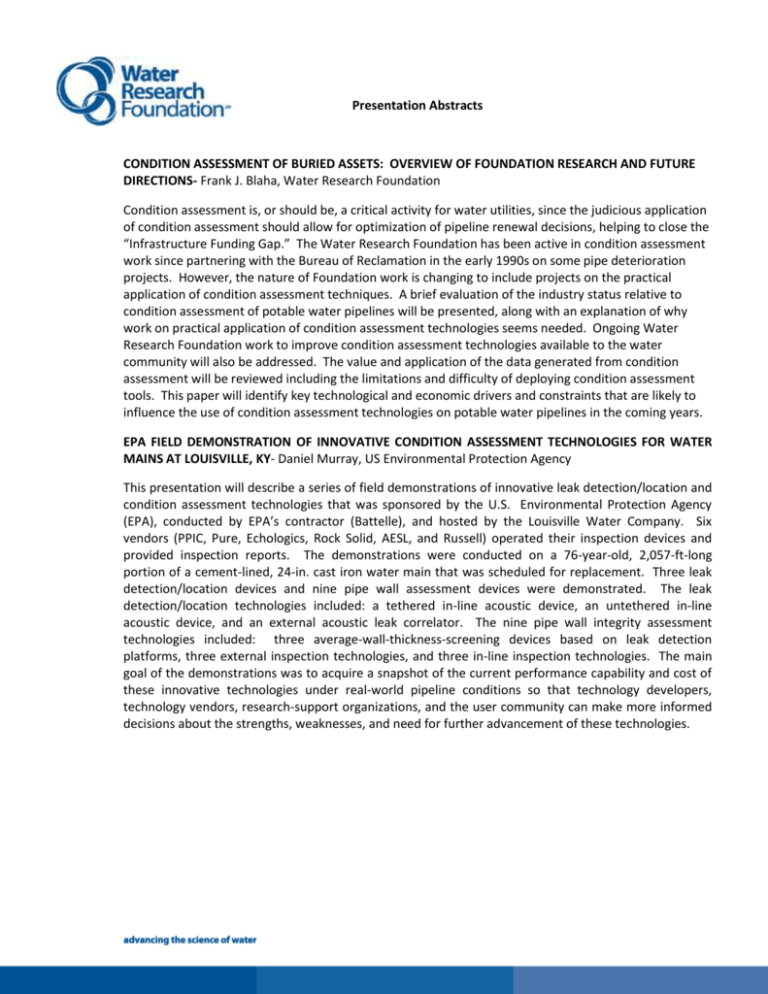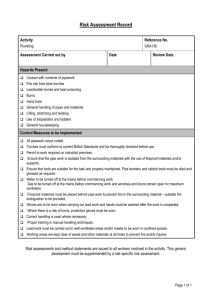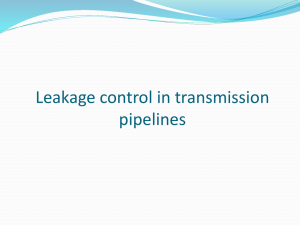Presentation Abstracts - WaterRF Collab
advertisement

Presentation Abstracts CONDITION ASSESSMENT OF BURIED ASSETS: OVERVIEW OF FOUNDATION RESEARCH AND FUTURE DIRECTIONS- Frank J. Blaha, Water Research Foundation Condition assessment is, or should be, a critical activity for water utilities, since the judicious application of condition assessment should allow for optimization of pipeline renewal decisions, helping to close the “Infrastructure Funding Gap.” The Water Research Foundation has been active in condition assessment work since partnering with the Bureau of Reclamation in the early 1990s on some pipe deterioration projects. However, the nature of Foundation work is changing to include projects on the practical application of condition assessment techniques. A brief evaluation of the industry status relative to condition assessment of potable water pipelines will be presented, along with an explanation of why work on practical application of condition assessment technologies seems needed. Ongoing Water Research Foundation work to improve condition assessment technologies available to the water community will also be addressed. The value and application of the data generated from condition assessment will be reviewed including the limitations and difficulty of deploying condition assessment tools. This paper will identify key technological and economic drivers and constraints that are likely to influence the use of condition assessment technologies on potable water pipelines in the coming years. EPA FIELD DEMONSTRATION OF INNOVATIVE CONDITION ASSESSMENT TECHNOLOGIES FOR WATER MAINS AT LOUISVILLE, KY- Daniel Murray, US Environmental Protection Agency This presentation will describe a series of field demonstrations of innovative leak detection/location and condition assessment technologies that was sponsored by the U.S. Environmental Protection Agency (EPA), conducted by EPA’s contractor (Battelle), and hosted by the Louisville Water Company. Six vendors (PPIC, Pure, Echologics, Rock Solid, AESL, and Russell) operated their inspection devices and provided inspection reports. The demonstrations were conducted on a 76-year-old, 2,057-ft-long portion of a cement-lined, 24-in. cast iron water main that was scheduled for replacement. Three leak detection/location devices and nine pipe wall assessment devices were demonstrated. The leak detection/location technologies included: a tethered in-line acoustic device, an untethered in-line acoustic device, and an external acoustic leak correlator. The nine pipe wall integrity assessment technologies included: three average-wall-thickness-screening devices based on leak detection platforms, three external inspection technologies, and three in-line inspection technologies. The main goal of the demonstrations was to acquire a snapshot of the current performance capability and cost of these innovative technologies under real-world pipeline conditions so that technology developers, technology vendors, research-support organizations, and the user community can make more informed decisions about the strengths, weaknesses, and need for further advancement of these technologies. CONDITION ASSESSMENT O FWATER PIPE IN AUSTRALIA: RESEARCH FROM DOWN UNDERGROUNDFrank Blaha, Water Research Foundation For the urban water industry, condition assessment and prediction of likely failures of the water distribution network is costly and becoming increasingly more critical as water distribution systems become older and hence more prone to failure. The tools and capabilities available to the water industry at present are deficient and have high levels of uncertainty. The net result is sub-optimal overall management of systems, including costly preventative intervention and prediction of major catastrophic events. Together these adversely impact the national economy, industry communities and the environment. This presentation will cover the recent research in condition assessment technologies and pipe failure prediction techniques from a Water Research Foundation/Australian research partnership program. USING NDE METHODS IN A SMALL DIAMETER MAIN RENEWAL PROGRAM-Dan Ellison, HDR Condition assessment tools that scan with precision the full-length of iron and steel water mains exist— in fact they have existed for nearly 20 years. The accuracy of these NDE tools has been demonstrated in various WaterRF projects. So why do we still base most of our replacement decision on leak histories and pipe ages? There are two reasons: (1) the use of these tools is relatively costly (many utilities would prefer to spend the money on new pipes instead), and (2) there are no standards for how to interpret the data and apply this information in the rehabilitation of pipes. Two current WaterRF project hope to help solve these problems. In the first project (“Leveraging Data from NDE…”), various NDE technologies will be tested on an old 6inch cast iron main. After exhuming the main, the results will be compared. Then, each of the 4 sponsors (LADWP, Denver Water, Fairfax Water, and DC Water) will select a technology to try for 3 days in one of their neighborhoods. The data from these tests will then be incorporated into the decision models currently used by each utility in selecting mains for renewal. The cost effectiveness of performing the NDE testing will then be evaluated. In the second project (“The Assess-and-Fix Approach…”), NDE will be incorporated into a water main rehabilitation project. The data from the NDE tests will be used to determine the lining method that is then applied. The technical challenge involves developing guidelines that match the condition of the existing pipe to the structural capabilities of various lining methods, taking into consideration future degradation of the host pipe. This presentation will provide an overview of the available NDE technologies, the technical issues associated with assessments, and the structural capabilities of lining technologies. DEVELOPING A STRATEGY FOR AC PIPE—a tailored collaboration with East Bay Municipal Water District-Dan Ellison, HDR Between the 1940s and the 1970s, more than 1,000 miles of Asbestos Cement Pipe (ACP) were installed by the East Bay Municipal Utility District (EBMUD) system, a water utility serving 1.3 million customers in Northern California. According to recent tests which show significant internal and external degradation, failure rates for this pipe could soon increase rapidly. If this forecast is true, these failures could overwhelm the utility’s ability to finance, repair, and replace the pipe. This presentation discusses a research project which aims at an accurate assessment of the condition of these AC pipes, a better model for estimating their life expectancies, and formulation of appropriate mitigation strategies, including water quality changes and novel rehabilitation approaches. LOUISVILLE WATER COMPANY’S CONDITION ASSESSMENT PROGRAM FOR PRE-STRESSED CONCRETE CYLINDER PIPE: THREE YEARS OF COUNTING WIRE BREAKS- Keith Coombs, Louisville Water Company On May 13, 2009 the Louisville Water Company (LWC) approach to condition assessment of pre-stressed concrete cylinder pipe (PCCP) changed forever. Prior to that date, we would often answer questions about the condition of our PCCP with puzzled looks. We had always heard about catastrophic failures, but they were always somewhere else, and quite frankly someone else’s problem. Prior to that date we had only experienced a handful of minor problems with PCCP; with most problems traceable to contractor workmanship. We were naïve. On May 13, 2009 we had a moment of clarity; a moment of growth. On that morning, a 60-inch embedded cylinder PCCP experienced a catastrophic failure. The break dumped 10,000,000 gallons of water in less than an hour, caused some property damage, temporarily interrupted service to thousands of customers and resulted in a boil water advisory for 23,000 customers. Luckily for LWC, the May 2009 failure occurred on a section of the main that had a redundant 36-inch supply main so we were able to restore system pressure within hours. Luckily, the break occurred at an opportune time; mid-morning in early May, after the morning draw and long before the peak summer demands of July and August. Luckily, the break occurred at an opportune location; limiting both property damage and access to the media. But luck, like hope are not good business strategies. A more aggressive approach was needed. In May 2009, while the repair crew was replacing four damaged sections of pipe, LWC launched what would become our Condition Assessment Program for PCCP. While the 60-inch main was out of service, we investigated over two miles of PCCP within the shut-down area around the break using a manned electromagnetic inspection platform. We identified a few additional sections of pipe that had experienced wire breakage. These mains were rehabilitated with metal bands while the main was shutdown. The 60-inch main was placed back in service within about 20 days. During the remainder of 2009 and into 2010, LWC developed the foundation for a fairly aggressive program to inspect all PCCP in our system. The presentation will provide the steps LWC went through to establish the program, what we have learned about PCCP - construction, installation, and repair - and what we learned about ourselves. MAKING DOLLARS (AND SENSE) OF CONDITION ASSESSMENT DATA: LESSONS LEARNED FROM THE TRENCHES - Tina Miller, Anchorage Water and Wastewater Collecting information on the condition of assets is a cornerstone idea for asset management, resulting in reducing the bottom line while maintaining service levels. Combining risk management with condition data can lead to even more gains. Anchorage Water & Wastewater Utility went through the process of implementing an asset management approach, starting with the basics of a solid inventory, desktop risk assessment, and follow up action of as much condition assessment as the budget could tolerate. In parallel, we expanded our desktop condition assessment by aggregating and digitizing historic data, such as over 15 years of water main break data stored on old maps. The field condition data on the large diameter pipe was invaluable as it helped reduce the risk cost. A statistical approach on failure prediction based on the enhanced desktop analysis from the break data was used for the smaller diameter pipe. With a combination of these approaches, Anchorage Water and Wastewater has been able to reduce its water 6 year CIP by $50 million dollars and dramatically refine the margin of uncertainty onlong range infrastructure replacement resulting in a more manageable long range infrastructure funding scenario. A HISTORY OF PIPE CONDITION ASSESSMENTS IN CALGARY – WHAT HAVE WE LEARNED? Roy Brander, P.Eng. and Andy Hughes M.Eng, P.Eng- City of Calgary The City of Calgary has been involved in pro-active pipe condition assessments since 1998 and has been a test bed for various new technologies emerging onto the market. We were among the first cities to assist Russell Technologies (now Russell NDE Systems) with their development of the HydroScope, now marketed as the “See-Snake” inspection tool, and have about 100km of our metallic system inspected with this remote-field technology (RFT). Major water mains failures have created significant issues for the Utility that required a strong response to reassure the public. On the major thoroughfare of McKnight Boulevard on January 25, 2004, a sudden failure releasing 20,000 tonnes of water became a major newspaper and television news story. Since then, not only has the City of Calgary has ramped up pro-active inspection and monitoring of the feedermain network, but also in other areas of the Utility such as sanitary forcemains, syphons and some collection mains. To date, the City of Calgary has undertaken a wide variety of pipe condition assessments and monitoring activities including: Yearly program of electromagnetic inspection of concrete feedermains (C-301L/E, C303) Yearly program of “See-Snake” RFT inspections of smaller diameter metallic water distribution mains Comparisons of electromagnetic inspection products for feedermains: o Pure Technology’s “P-Wave” o PPIC RFEC/TC design. Acoustic Fibre Optic monitoring of PCCP feedermains with Pure Technology’s “AFO” product since 2004 Acoustic Emission Testing monitoring of (different) PCCP main with PPIC product, since 2008 Piloting of newer technologies including: o Pure Technologies’ SmartBall leak detection o Echologic’s LeakFinderRT/PIT system for acoustic leak detection. o RedZone Robotics Responder inspection technology (for a sanitary sewer siphon) Yearly soil sampling program to “tour the system” over the next few decades, looking for corrosive risk areas. This presentation will provide an overview of what we do at the City of Calgary in relation to active pipe condition assessments, share lessons learned and also shed some light on what technologies are working better for us.





